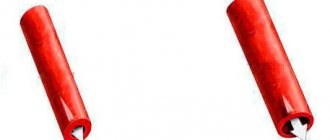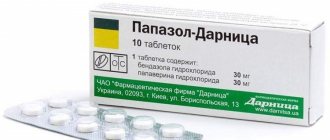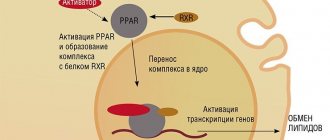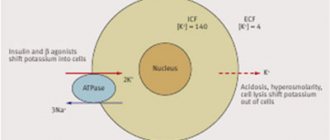Indications for use
Peripheral vasodilator drugs are indicated for circulatory disorders in peripheral organs and tissues associated with narrowing of the lumen of the vessel: atherosclerotic plaque (vascular atherosclerosis obliterans), inflamed vascular wall (endarteritis obliterans), pathological reflex spasm (Raynaud's disease).
Peripheral vasodilators are used for circulatory disorders in the vessels of the lower extremities, which are accompanied by intermittent claudication, trophic ulcers, pain in the legs at rest, sensory disturbances, and spasms in the calf muscles.
Peripheral vasodilators are also used for vascular complications due to diabetes mellitus (diabetic angiopathy), up to the initial stages of gangrene of the foot.
In addition, drugs of peripheral vasodilators are used for chronic disorders of cerebral circulation - cerebral atherosclerosis, dyscirculatory encephalopathy, chronic cerebral vascular insufficiency.
Peripheral vasodilators are indicated for behavioral and mental disorders in old age, in patients after stroke, coma, and insufficient blood supply to the retina and inner ear.
Certain drugs of peripheral vasodilators (bendazole and its combinations with papaverine) are used for arterial hypertension and hypertensive crisis.
Vasoactive drugs in the treatment of ischemic retinal diseases
Various diseases of the retina and optic nerve, caused by both general and local circulatory disorders, occupy a significant place among the causes of visual disability. Despite the undoubted successes in the treatment of vascular pathology of the eye, achieved in the last two decades, the number of patients with lesions of the optic nerve and retina continues to increase. This increase in the number of vascular diseases of the eye is directly related to the widespread prevalence of hypertension, atherosclerosis and diabetes,
which are practically impossible to cure. Existing treatment methods are aimed only at slowing down the development of the pathological process or stabilizing the functions of the affected organs. Ischemia is the most common pathological process that accompanies or causes ocular pathology.
As in other areas of practical medicine, in ophthalmology two main forms of the course of the ischemic process can be distinguished - acute and chronic
. This requires a different approach to the choice of treatment methods, as well as medications.
The use of vasoactive drugs as one of the links in the complex treatment of ischemic processes in the optic nerve and retina requires a careful and individual approach.
Drug treatment aimed at dilating blood vessels is often insufficient to improve blood circulation, and sometimes can even worsen ocular ischemia due to the development of “steal” syndrome. In this regard, it is necessary to increase perfusion, especially at the level of precapillaries and the arteriolar part of the capillary network.
The drugs most often used in the complex treatment of ischemic diseases are :
• improving blood circulation in the cerebral vascular system
(vinca preparations, pentoxifylline, nicergoline, cinnarizine);
• agents that dilate peripheral vessels and improve blood circulation at the capillary level
(xanthine nicotinate);
• vitamins
;
• means that improve redox and metabolic processes in the body
;
• biostimulants
;
• antioxidants, etc.
Drugs with a vasodilating effect are widely used to treat cardiovascular diseases. Vasodilators
divided into three main groups:
• direct acting vasodilators;
• calcium antagonists;
• blockers of postsynaptic a1-adrenergic receptors.
Among the direct acting vasodilators,
which in turn can be arterial, venous and arteriolar-venous, in practical ophthalmology venous vasodilators (nitroglycerin and other nitrates) were previously used for acute ischemia. Nitrates relax the smooth muscles of arteries and veins. But there is no accurate data yet that this improves the perfusion of the vessels of the eye. According to some data, under conditions of general redistribution of blood flow, the blood supply system of the eye may fall into the “stealing” zone. Doses of nitroglycerin that do not cause changes in systemic blood pressure (BP) often lead to dilation of arterioles in the face and neck, a rush of blood to the head and headache due to dilation of the meningeal vessels. According to M.M. Krasnov, a narrowing of the visual field and an increase in scotomas are often observed when taking nitrates.
The use of drugs acting through local factors that help reduce vascular tone and improve hydrodynamic parameters of the blood turned out to be more justified. Myotropic vasodilators have been used for many years to enhance peripheral circulation in areas where it is impaired due to acute or chronic vasoconstriction or spasm. Among the vasodilators currently most widely used in ophthalmology are nicotinic acid, xanthinol nicotinate, vinca preparations, and pentoxifylline.
. Using rheoophthalmography, a fairly high degree of vasodilating effect of the listed drugs on the vascular tract of the eye has been repeatedly proven.
Vinca preparations have a pronounced vasodilating effect on intraocular vessels.
, while they act anabolically, enhance the absorption of oxygen by brain cells and have an anti-aggregation effect. The therapeutic effect of vinca preparations develops gradually. In our clinic, vinca preparations were used for the treatment of acute (ischemic neuropathies, occlusion of the branches of the central retinal artery) and chronic (glaucomatous optic atrophy, dry form of senile retinal degeneration) ischemic diseases, 10 mg intravenously 1 time per day for 7–10 days . Upon discharge, the drug was prescribed 5 mg tablets 3 times a day for 2–3 months.
Many authors have noted the most pronounced vasodilatory effect when using drugs containing nicotinic acid
.
However, many authors consider the effectiveness of vasodilators in cerebrovascular insufficiency to be questionable. Myotropic vasodilators are capable of increasing cerebral blood flow under physiological conditions. With vascular pathology, which often accompanies ocular ischemia or is its cause, the affected areas of the vessels react less strongly to them. In addition, it is known that in poorly perfused areas, blood circulation can improve by increasing blood pressure. When using drugs of this group, especially intravenously, there is a drop in systemic blood pressure, which can lead to the development of “steal” syndrome.
For the same reasons, some ophthalmologists express doubts about the advisability of prescribing vasodilators for glaucoma, arguing that a decrease in systemic blood pressure can lead to a deterioration in the blood supply to the eye due to a decrease in perfusion pressure. However, most studies have found that blood supply to the eye improves under the influence of vasodilators when systemic blood pressure decreases by no more than 10% from the initial level. A more significant decrease in blood pressure leads to a deterioration in the blood supply to the eye in some patients.
Considering that the effect after
lasts
for 2–8 months
; courses of drug treatment must be carried out 2–3 times a year.
In addition, other methods of therapy have been developed based on improving the rheological parameters of blood (increasing the deformability of erythrocytes, reducing their aggregability, etc.). Many of the modern drugs used to treat ischemic conditions of the eye combine several of these properties simultaneously.
Quite widely in ophthalmology, purine derivatives are used to treat ischemic conditions of the posterior segment of the eye. Xanthinol nicotinate
reduces the level of fibrinogen in the blood and the aggregation ability of platelets, reduces blood viscosity. With long-term use of xanthinol, nicotinate helps lower blood levels of cholesterol and atherogenic lipoproteins. The drug can be used (as part of a complex treatment) intravenously (preferably by drip, 300 mg per 200 ml of saline once a day), intramuscularly (300 mg once a day) and parabulbarly (75 mg each) for 7–10 days, after which you should switch to the tablet form for 2–3 months.
Pentoxifylline is also a purine alkaloid.
. The classification of pentoxifylline into the group of vasodilators is very conditional, since it has a mild vasodilator effect, with almost no effect on hemodynamic parameters. The action of pentoxifylline is based on its effect on the hydrodynamic properties of blood. This drug acts on the rheological properties of the blood, on the one hand, and on tissue metabolism, on the other. In a hospital setting, it is advisable to prescribe pentoxifylline once a day intravenously, 5 ml of solution (100 mg) and/or parabulbar 10–15 mg for 7–10 days. After discharge from the hospital, the drug is prescribed at a dose of 400 mg 3 times a day for 2–3 months.
Another drug that deserves attention is picamilon, which consists of two biogenic components - GABA and nicotinic acid.
Among the many properties of picamilon, the most important are its antihypoxic, antioxidant, and vasodilating properties. In addition, it has been proven that picamilon reduces platelet aggregation ability and has anticoagulant and antiatherosclerotic effects.
The therapeutic activity of picamilon was studied in the treatment of compensated glaucoma, retinal pigmentary abiotrophy, ischemic neuropathy, and central chorioretinal dystrophy. According to a number of authors, after a course of treatment with picamilon (0.02 g 3 times a day orally), in 34-45% of patients, depending on the stage of the disease, there was an improvement in eye hemodynamics, an increase in light sensitivity, an expansion of the peripheral boundaries of the visual field, and a decrease in the area with a cat.
A relatively new and promising direction in vascular therapy, in our opinion, is the use of calcium antagonists for the treatment of acute and chronic vascular pathology of the posterior part of the eye. The most interesting for research is nimodipine
, which is so far the only drug from this group that has a cerebral effect. There are isolated reports of the use of nifedipine, isradipine, diltiazem and verapamil in tablet form in the treatment of open-angle compensated glaucoma. Studies have proven the positive effect of calcium channel blockers on ocular hemodynamics. A decrease in peripheral vascular resistance and an increase in perfusion pressure in intraocular vessels were noted. Visual functions stabilized or improved. In 6 patients, we successfully used nimodipine in the complex treatment of acute ischemia (occlusion of the branches of the central retinal artery and ischemic neuropathy).
It is necessary to say a few words about the methods of administering drugs.
Intravenous and parabulbar methods of administering vasoactive drugs are traditional in ophthalmology. However, a number of disadvantages of these methods reduce the effectiveness of the use of drugs. In particular, intravenous administration of vasodilators to a greater extent than local (retro- and parabulbar, subconjunctival) affects blood pressure, which increases the likelihood of deterioration of blood circulation in the eye due to a decrease in perfusion pressure. With parabulbar injections, the main part of the drug enters the orbital tissue, where there are many blood vessels and the drugs are quickly carried out by the blood from the eye area.
In 1991, A.P. Nesterov and S.N. Basinsky proposed a new method - the introduction of drugs into Tenon’s space using sub-Tenon implantation of a collagen infusion system
(SIKIS), which was mainly used to treat glaucomatous optic atrophy. In our studies, we compared the effectiveness of three methods of drug administration - intravenous, parabulbar and using SICIS. The effectiveness of vasoactive drugs was highest after the use of a collagen infusion system. The use of SICIS made it possible to achieve the maximum effect of drugs introduced into Tenon's space.
Thus, the use of vasoactive drugs in the complex treatment of ischemic diseases of the retina and optic nerve can be considered necessary.
Literature
1. Bunin A.Ya., Conde L.A. On the critical level of systemic blood pressure when prescribing vasodilators to patients with glaucoma // Vestn. ophthalmol. 1983; 3: 17-20.
1. Bunin A.Ya., Conde L.A. On the critical level of systemic blood pressure when prescribing vasodilators to patients with glaucoma // Vestn. ophthalmol. 1983; 3: 17-20.
2. Krasnov M.M. To analyze the features of intraocular hemodynamics and the possibility of therapeutic effects on it in glaucoma and blood supply deficiency. // Vestn. ophthalmol. 1989; 6: 36-43.
3. Metelitsa V.I. Cardiologist's Handbook of Clinical Pharmacology. M. 1987; 367 pp.
4. Egorov E.A., Svirin A.V., Puzakov V.P. The use of Cavinton in the complex treatment of glaucoma and some other eye diseases // New drugs used in ophthalmology. M. 1978; 62-4.
5. Katsnelson L.A., Mikhailova N.A., Gurtovaya E.E., Yakovlev A.A. Results of an experimental and clinical study of the drug trental//Vestn. ophthalmol. 1980; 1:41-3.
6. Tikhomirova N.A., Sukhorukova A.Yu. Local use of the drug “Cavinton” for vascular eye diseases. – In the book: Pathology of the fundus. Abstracts of conference reports. M. 1986; 50-1.
7. Konde L.A., Yakovlev A.A. On the mechanism of therapeutic action of a new drug complex aimed at stabilizing visual functions in patients with primary glaucoma // Pathophysiology and biochemistry of the eye. M. 1986; 25-30.
8. Konde L.A., Yakovlev A.A. Experience of using Cavinton in the treatment of glaucoma // Glaucoma. M. 1984; 59-61.
9. Gabrilyan E.S., Amroyan E.A., Akopov S.E. Physiology and pharmacology of the vascular wall. - Yerevan. 1987; 279 p.
10. Mashkovsky M.D. Medicines. M.: Medicine. 1993; 738 pp.
11. Ishchenko M.M., Dorogiy A.N. The effect of complamin on systemic and cerebral hemodynamics in patients with atherosclerosis and chronic cerebrovascular accident // Neuropathology and Psychiatry. 1985; 1: 17-20.
12. Stefanovich V. On the question of the biochemical mechanism of action of pentoxifylline // In collection. Clinical significance of the drug trental. M. 1977; 16-8.
13. Kruger A, Matulla B, Wolzt M. et al. Short-term oral pentoxifylline use increases choroidal blood flow in patients with age-related macular degeneration // Arch. Ophthalmol. 1998; 116 (1): 27-30.
14. Bondareva G.S., Umovist N.M. On the differentiated use of trental, complamin, solcoseryl and increased doses of vitamin B6 in the complex treatment of retinal dystrophy. Current issues in the pathology of the posterior part of the eye. Abstracts of reports. – Odessa. 1989; 107-8.
15. Davydova G.A., Kolomoitseva E.M., Eliseeva E.G., Pereverzina O.K. Results of the use of picamilon in some eye diseases // Picamilon in medical practice. M. 1997; 50-5.
16. Kolomoitseva E.M., Mukha A.I. On the effect of picamilon on the visual functions of patients with open-angle glaucoma // Picamilon in modern neurological and psychiatric practice / Proceedings of the Russian Conference. Moscow, November. 1994; 157-160.
17. Efimova M.N., Yakubova L.V. The influence of the calcium antagonist nifidipine on the visual functions of patients with primary glaucoma // Issues of ophthalmology. Omsk 1994; 137-9.
18. Efimova M.N., Yakubova L.V. Immediate results of the influence of systemic administration of calcium antagonists on the visual fields of patients with primary open-angle glaucoma with normalized pressure // Glaucoma. M. 1994; 82-4.
19. Yakubova L.V. The use of vasoselective calcium antagonists in the complex treatment of patients with primary open-angle glaucoma with normal intraocular pressure. Dissertation of a candidate of medical sciences. M. 1995; 146 p.
20. Brand L., Anderson K., Junegreen B. et al. Cerebrovascular and cerebral effects of nimodipini – an update // Acta Neurochir. 1988; 45 (1): 11-20.
21. Netland PA, Chaturvedi N., Dreyer EB Calcium channel blockers in the management of low-tension and open-angle glaucoma // Am. J. Ophthalmol. 1993; 115: 608-13.
22. Varno M., Pecori Giraldi J., Covelli GP et al. Effetti della nimodipina sulla sensibilita retinica nella neurotticopatia glaucomatosa // Bollettino di oculistica. 1990; 69 (5): 449-55.
23. Flammer J. Psychophysical mechanisms and treatment of vasospastic disorders in normal-tension glaucoma // Bull. Soc. Belge. Ophthalmol. 1992; 244: 129-34.
| Applications to the article |
| “Flying floaters” before the eyes are not dangerous and do not require treatment, but their sudden appearance in a myopic eye can be a symptom of incipient retinal detachment and requires immediate examination by an ophthalmologist. |
| The maximum time for continuous work at a computer is 10–15 minutes for younger schoolchildren, 25–30 minutes for older students, and 3 hours a day for senior students. |
| The desirable medicinal effects of tricyclic antidepressants (amitriptyline, etc.) include tear hyposecretion, pupil dilation, accommodation paresis, increased IOP, and even an acute attack of angle-closure glaucoma. |
| Ischemia is the most common pathological process in ocular pathology |
| Administration of drugs using sub-Tenon implantation of a collagen infusion system can enhance and prolong their effect |
Classification of peripheral vasodilator drugs
Peripheral vasodilator drugs are classified according to their chemical structure and origin into:
- 2-amino-1-phenylethanol derivatives: isoxsuprine;
- nicotinic acid preparations: nicotinic acid;
- purine derivatives: xanthinol nicotinate, pentoxifylline;
- ergot alkaloids: nicergoline;
- Vinca alkaloids: vincamine;
- others: naftidofuryl, bendazole, bencyclane.
In addition, magnesium sulfate, hydralazine, antihypertensive drugs - calcium antagonists (amlodipine, nifedipine, felodipine, isradipine, nitrendipine), nitric oxide donors (sodium nitroprusside), potassium channel activators (minoxidil, diazoxide) have a peripheral vasodilating effect.
There are also combination preparations of the peripheral vasodilator bendazole with the myotropic antispasmodic papaverine.
Features of treatment with peripheral vasodilator drugs
Due to the high risk of shock and collapse - a sharp drop in blood pressure with loss of consciousness - peripheral vasodilator drugs are prescribed with caution to people with hypotension (low blood pressure).
Peripheral vasodilator drugs, lowering blood pressure, with a sharp change in the horizontal position of the body to a vertical one, can lead to an outflow of blood from the brain, which is manifested by dizziness and even loss of consciousness. This condition is called orthostatic hypotension. To prevent the development of such an effect after taking peripheral vasodilator drugs, the patient should lie down or sit for about half an hour, without getting up suddenly.
Since peripheral vasodilator drugs thin the blood, having an antiplatelet effect, their use is contraindicated in patients with reduced blood clotting and uncontrolled bleeding.
When using peripheral vasodilator drugs, you should stop drinking alcohol and smoking.
Instructions for use of drugs, analogues, reviews
Peripheral circulation - blood flow in small arteries, arterioles, capillaries, postcapillary venules, arteriovenular anastomoses, venules and small veins. As a result of structural or functional disorders, the following circulatory disorders may occur:
1) Arterial hyperemia - an increase in the filling of tissues with arterial blood. It manifests itself as redness and warming of the skin over the affected area. It develops under the influence of chemicals, toxins, inflammatory products, fever, and allergies. 2) Venous hyperemia - an increase in blood supply to an organ or tissue as a result of obstructed blood outflow through the veins. Manifested by blueness of the tissues. Causes: compression of veins or their blockage, weakening of the heart muscle, obstruction of blood flow in the pulmonary circulation. 3) Ischemia - limited or complete disruption of the arterial blood supply. Causes: compression, blockage or spasm of the arteries. It manifests itself as pain due to the accumulation, under conditions of reduced oxygen supply to the tissues, of under-oxidized metabolic products - inflammatory mediators. 4) Stasis - slowing down and stopping blood flow in capillaries, small arteries and veins. Causes: high or low temperatures, poisoning, high concentrations of table salt, turpentine, mustard oil, microbial toxins. 5) Thrombosis - the formation of blood clots consisting of its elements and preventing normal blood flow. It manifests itself as swelling and cyanosis of the tissues. 6) Embolism - blockage of blood vessels by foreign bodies (microorganisms, drops of fat) or gases.
Clinical forms of peripheral circulatory disorders include obliterating endarteritis, thrombophlebitis and phlebothrombosis, pulmonary embolism, chronic cerebrovascular accidents, varicose veins of the lower extremities, eye diseases of ischemic origin, Raynaud's disease. The complaints that patients make are varied. You should contact a specialist if:
- pain in the legs at the end of the day, when walking or standing for a long time; swelling and cyanosis of the lower extremities; - there are headaches, tinnitus, hearing loss, sleep disturbances, memory disorders, unsteadiness when walking, numbness in the arm or leg, speech disorders, swallowing disorders; - there is chilliness in the hands, pain in the fingers during exertion, whitening of the hands when cooling; - there is a decrease in visual acuity or loss of visual fields.
Means for improving peripheral circulation
Drugs that improve peripheral circulation include: 1) Drugs that improve microcirculation. Angioprotectors. They normalize capillary permeability and improve metabolic processes in the walls of blood vessels. Curantyl (dipyridomole), persantine, trental, flexital, vasonite, radomin, pentoxifylline, doxy-chem. 2) Preparations of low molecular weight dextran. The drugs attract additional volumes of blood from the intercellular space into the bloodstream. Improves blood fluidity. Reomacrodex, reopoliglucin. 3) Preparations of prostaglandin E1. Improves blood flow, microcirculation, and elasticity of red blood cells. Increases blood anticoagulant activity. Dilates blood vessels, reducing peripheral vascular resistance and blood pressure. Vazaprostan. 4) Calcium channel blockers. They improve microcirculation of brain vessels and have a cerebroprotective effect. Used primarily for cerebrovascular accidents. Cordafen, cordaflex, nimotop, stugeron, cinnarizine, adalat, arifon, grindeke, brainal, diacordin, cordipin, cortiazem, logax, lacipil, nafadil, nemotan, nifecard, stamlo, foridon, cinedil, cinnasan, plendil, norvax. 5) Myotropic antispasmodics. Drugs in this group are capable of dilating blood vessels, increasing cerebral blood flow. They are highly effective in treating cerebral vascular spasms. Less effective for vascular damage due to atherosclerosis. The disadvantages of drugs (except for Cavinton) include the phenomenon of stealing - dilation of predominantly intact vessels with a decrease in blood flow to starving areas of the brain. Drugs in this group have the ability to dilate blood vessels, increasing cerebral blood flow. As a rule, they are highly effective for spasms of cerebral vessels, but with the development of sclerotic processes, the ability of cerebral vessels to relax decreases and, consequently, the effectiveness of the action of vasodilators decreases. In addition, these drugs can cause the phenomenon of intracerebral “steal” (absent in Cavinton), when, under the influence of vasodilators, a preferential expansion of intact vessels occurs and blood flow is redistributed in favor of healthy areas of the brain. No-shpa, no-shpa forte, drotaverine, halidor, cavinton, mydocalm, nikoshpan, spasmol, aminophylline. 6) Herbal medicines. Preparations made from natural raw materials. Unlike synthetic drugs, the effect of this group develops more slowly; the therapeutic effect is exerted by a combination of compounds. Effective for diseases of cerebral vessels and obliterating diseases of the lower extremities. Bilobil, tanakan 7) Bioflavonoids. They have the ability to improve blood fluidity by increasing the elasticity of red blood cells. Normalize capillary blood flow. Venoruton, troxevasin, anthoxide. Ganglioblockers. They dilate arterioles, venules, and small veins, thereby achieving a decrease in blood pressure. Promote the redistribution of blood into the vessels of the lower extremities. Dimecoline, camphonium, pachycarpine, pentamine, pyrylene, temekhin, 9) Alpha-blockers. They cause dilation of blood vessels in the skin, kidneys, intestines, especially arterioles and precapillaries, reducing their overall resistance, improving blood supply to peripheral tissues. Sermion, nilogrin, prazosin, pyrroxan, phentolamine. 10) Dopamine receptor stimulants. The vasodilating effect is carried out due to the stimulation of dopamine receptors, which are also present in the vessels of the lower extremities. Increases blood flow in the vessels of the lower extremities. Pronoran.
Normalize capillary blood flow. Venoruton, troxevasin, anthoxide. Ganglioblockers. They dilate arterioles, venules, and small veins, thereby achieving a decrease in blood pressure. Promote the redistribution of blood into the vessels of the lower extremities. Dimecoline, camphonium, pachycarpine, pentamine, pyrylene, temekhin, 9) Alpha-blockers. They cause dilation of blood vessels in the skin, kidneys, intestines, especially arterioles and precapillaries, reducing their overall resistance, improving blood supply to peripheral tissues. Sermion, nilogrin, prazosin, pyrroxan, phentolamine. 10) Dopamine receptor stimulants. The vasodilating effect is carried out due to the stimulation of dopamine receptors, which are also present in the vessels of the lower extremities. Increases blood flow in the vessels of the lower extremities. Pronoran.
Since diseases based on impaired peripheral blood flow lead to disability without timely treatment, self-medication is contraindicated.







